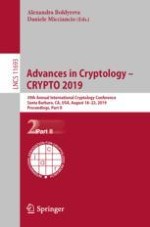2019 | OriginalPaper | Chapter
Realizing Chosen Ciphertext Security Generically in Attribute-Based Encryption and Predicate Encryption
Authors : Venkata Koppula, Brent Waters
Published in: Advances in Cryptology – CRYPTO 2019
Publisher: Springer International Publishing
Activate our intelligent search to find suitable subject content or patents.
Select sections of text to find matching patents with Artificial Intelligence. powered by
Select sections of text to find additional relevant content using AI-assisted search. powered by



